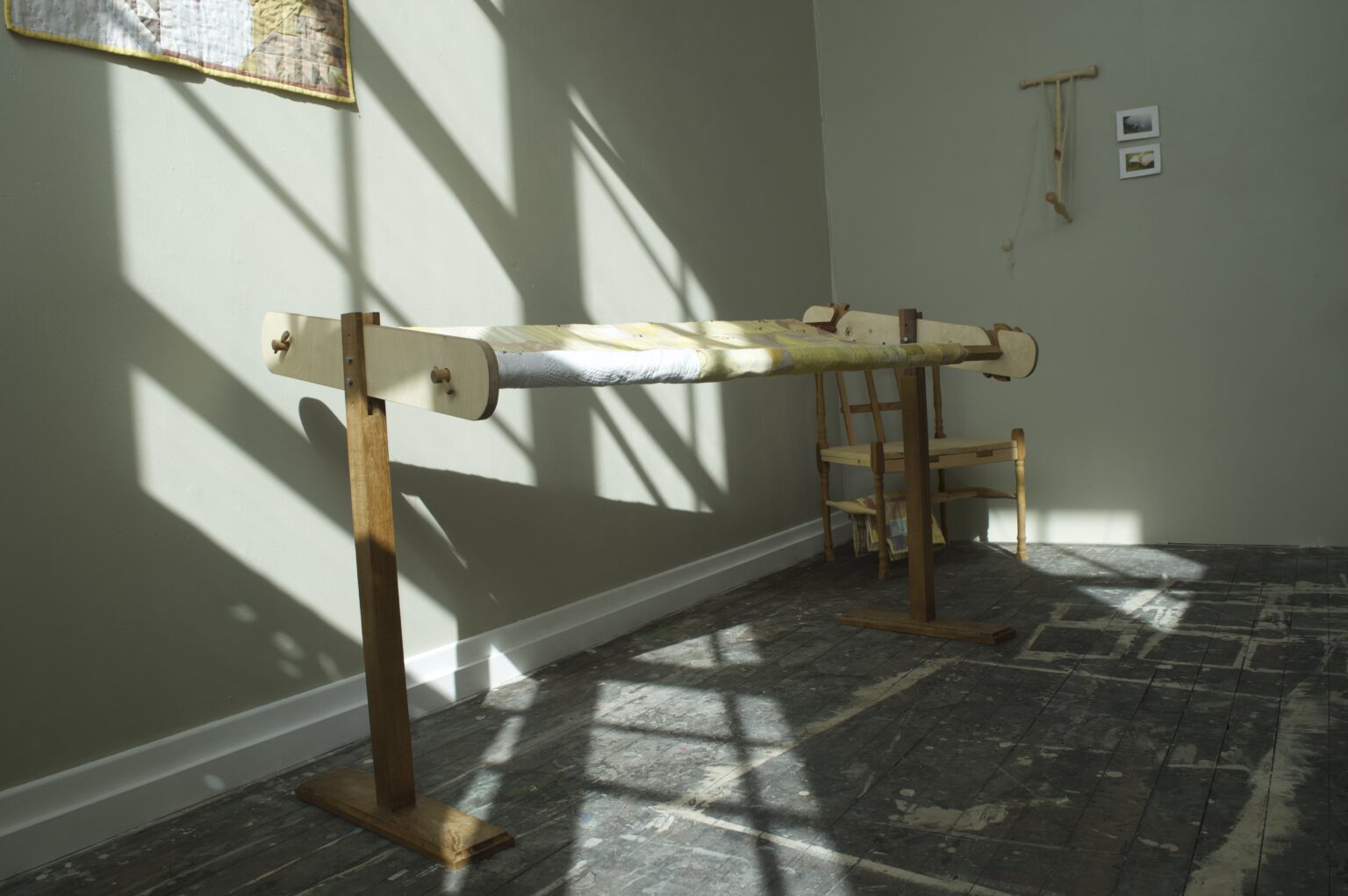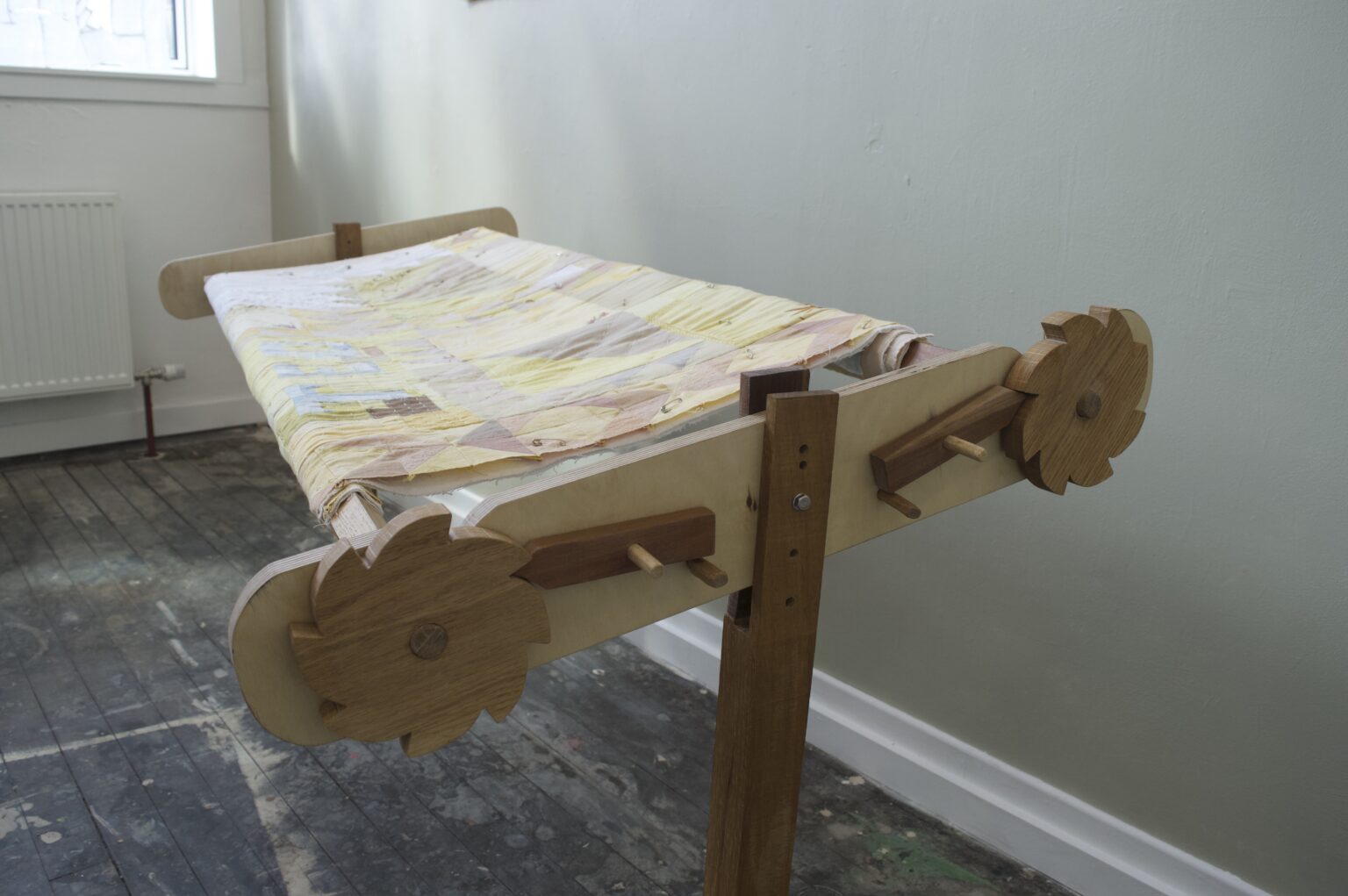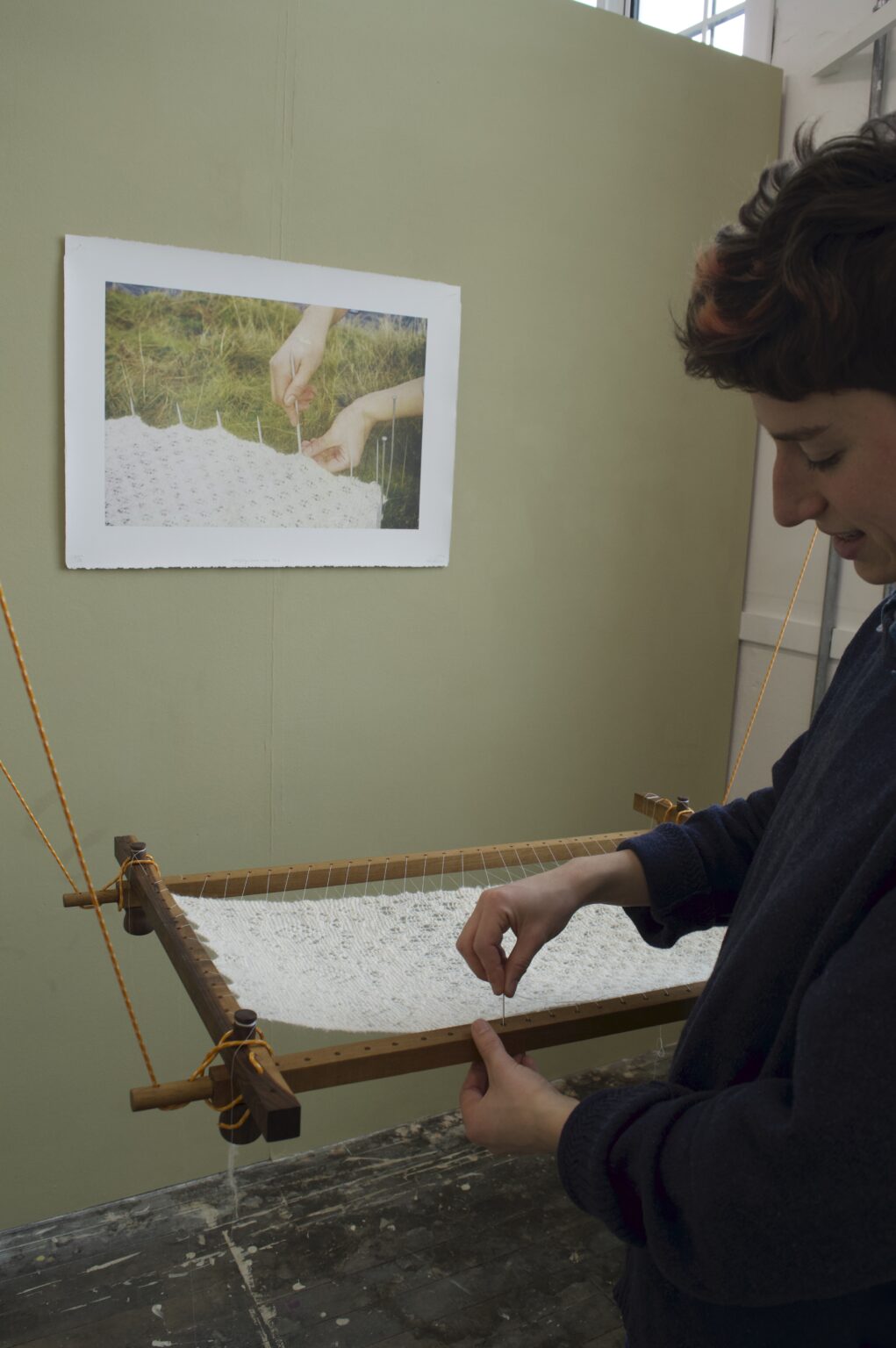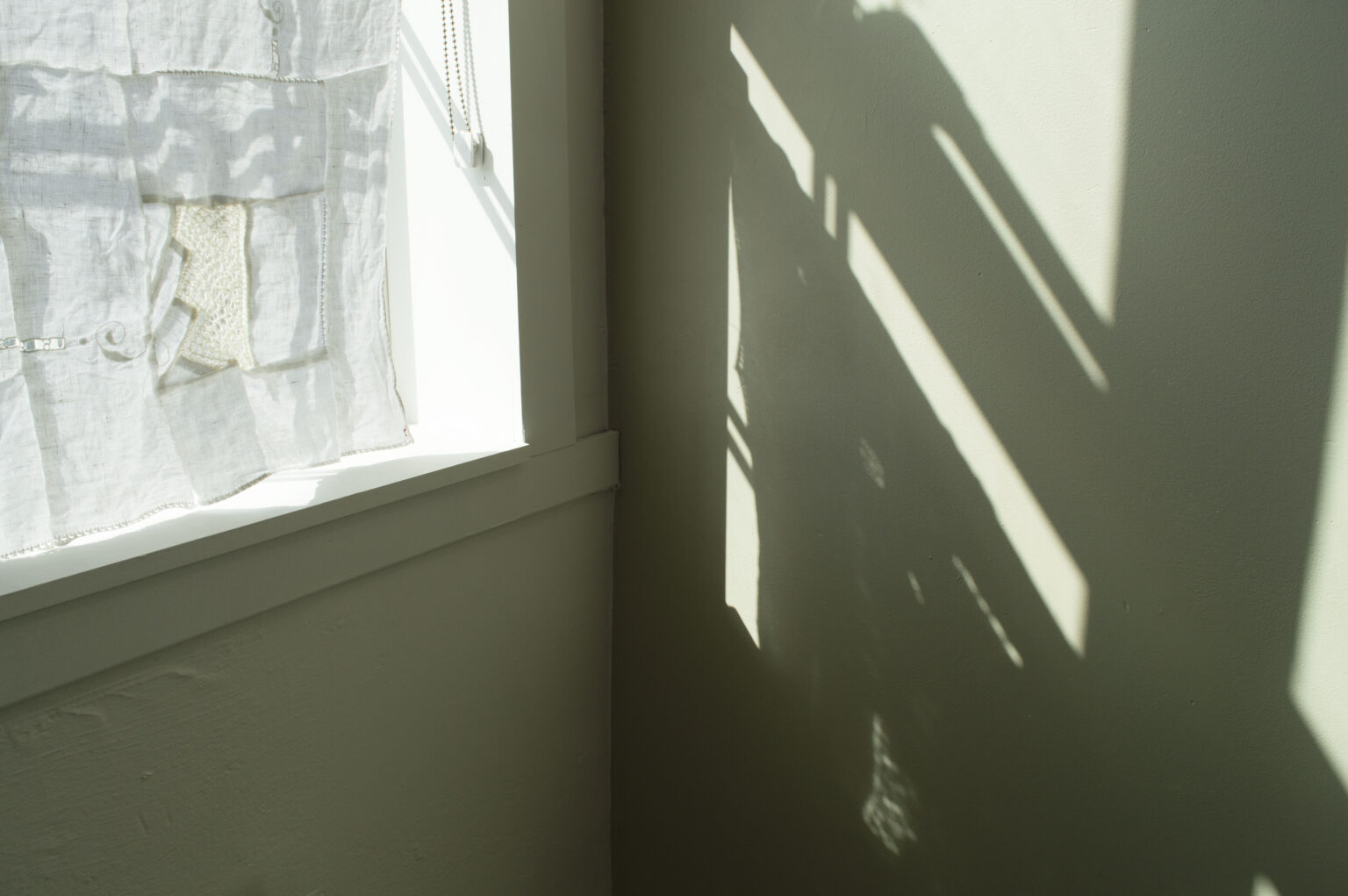Ted Tinkler (they/them)

My practice centres around handcrafts – playing with ideas of intimacy, liveliness, multiplicity, and trans-ness. I work with the animacy and performativity of crafted objects. They are my co-collaborators. Access and care are at the heart of my practice. I move through making by prioritising intimacy, space, and vulnerability over a productionist, scarcity-based mindset. My work tends to a slowtime.
I make with tangibility. From the queer histories of handkerchiefs, to the processes of physicality embedded within the crafts of Shetland lace knitting, quilting, spinning, and wood-working.
These animate objects give a framework to speculatively re-imagine care through radical, feminist, race, disability, and queer theory. How may my practice contribute to a library of liberatory tools that speculatively imagine (futures of) care?

“they are containers of fluidity”
Deep in the details of hand crafts.
Of spinning, knitting, quilt-making, and wood-working.
This installation is made of many hands.
These objects are full of liveliness and animacy.
Of tales and futures. Of deep roots covered in soil. Of naming as personhood.
Of intimacy lying at the boundaries. As sites of radical, speculative imagination. To cross these boundaries. Back and forth.
Multimedia installation of hand-crafted craft tools for hand-crafts. – (Suspended hap frame, with hand-lathed pulley system [handmade with walnut, bocote, and oak]. 4 plate photolithographs. White linen quilt top with embedded hand-knitted Shetland lace samples – on hand-lathed oak. Standing quilt frame for hand-quilting [handmade with oak, iroko, and cherry]. TED quilt [in progress] made with coreopsis, buddleia, indigo, woad, dock leaves, found linen and cotton tablecloths and handkerchiefs, and a woollen blanket. Naturally dyed, in community, bird/tree of life quilt block. Scrap chair of gender-queer joy made in collaboration with Jules Dunn [oak, iroko, and pine] with scrap seat-top quilt. Hand-lathed, pine, niddy noddy wound with white, hand-spun wool. Spinning wheel from unknown maker, in traditional design of Scottish flax spinning wheels. Paper, books, zines, sewing pins, cork, wool, coreopsis. Quilt top of a lace pattern [naturally dyed].)
A large print installation description is available. Touch objects are also available and are intended to be handled by all visitors, especially those with different cognitive processing needs and low-vision and blind visitors. You can access an audio guide via the QR code (at https://linktr.ee/tedtinkler) that contains a visual description of all the objects in this installation – written and recorded by the artist.


Sitting amongst the strong early evening light in "they are containers of fluidity"

Hand-made Scrap Chair and Quilt

Quilt Frame

Knitted Lace in Suspended Hap Frame

"pegging down their lace"

bird/tree of life quilt

Hanging Lace and Linen Quilt Top
“pegging down their lace”
Hand-spun Shetland wool, fir cone knitted-lace, steel knitting needles, 35mm film, queer bodies, loch Humphrey, soil, moss sporophytes, grass tussocks, 4 plate colour lithography on zerkall paper, hand-made iroko and bocote suspended hap frame, on hand-lathed oak pulley system.
Spun, knitted, performed, and printed by Ted Tinkler.
Photography by Meadhbh Corrigan. Support by Kitt Glover.



from seed, to soil, to dye, to craft
A series of workshops over the cyclical growing season, from March 2022 to January 2023, facilitated by Ted Tinkler. From sowing the seeds, gardening, harvesting, dyeing, and a craft skill-share.
“It is a pleasure to gently move through these seasons and to learn together – of care, craft, interdependency, soil, stewardship – and more that can only be recorded in the ephemeral. Here we celebrate the time this has made.
With deep thanks to all those who have been a part of and supported these workshops. To Astrid, Beth, Chiara, Ciaran, Euysun, Helen, Ioanna, Jeong, Kitty, Marie, Meadhbh, Megan, Mia, Polina, Rachel, Sarah, Sarah, and Simone.
Love, Ted”
Project Links
from land to lace
from sheep, to shawl, from land, to lace.
Lace Knitting on the Shetland Islands – Tales of Imagining, Naming, and Recording Patterns.
hand-printed lithography zine, edition of 40
(price on request, sliding scale)
All parts of the lace shawl making process can be completed on Shetland – from the sheep; to the spinning of yarn; to the imagination of patterns; and to the knitting itself. This zine came about through a research trip to Shetland in August 2022, generously funded by GSA Sustainability.
“they are containers of fluidity” touch-based workshop
https://www.eventbrite.co.uk/e/touch-based-performative-workshop-in-they-are-containers-of-fluidity-tickets-644275353927
Date and Time: Sunday 4th June, 11am – 12.30pm
Location: Room 22, Space 17, 4th floor, Stow Building, 64 Shamrock Street, G4 9JZ
Event Description:
This touch-based performative workshop will combine a ‘touch tour’, spoken word pieces, and space for conversation and questioning. We will give focus to touching hand-made craft objects, naming their details, and enjoying their tactility. To name a few – hand-knitted lace, naturally dyed quilts, and a hand-lathed, wooden ‘niddy noddy’ for spinning…
The event will entirely take place within the installation titled “they are containers of fluidity”, in the back-right corner of room 4.22.
There are a limited number of spaces available so if, for any reason, you can no longer make the event please cancel your booking/let us know so we can offer the space to someone else.
Access Information:
All are welcome – please contact Ted at T.Tinkler1@student.gsa.ac.uk for any additional information, access needs, or support.
“they are containers of fluidity” is located on the 4th floor and is accessible via stairs or lifts. There are no steps between the lift and the room. The room will be lit via the main lights and there is a large window in the space. The building has disabled and gender-neutral toilet facilities. The event will be relaxed, with no pressure to participate, and all attendants are free to take their time and/or leave the space if they need to. There is also a quiet room that the artist can direct participants too, and the installation itself is a quiet, calm space. There will be a variety of seating options available.
A large print installation description is available. Touch objects are also available and are intended to be handled by all visitors, especially those with different cognitive processing needs and low-vision and blind visitors. You can access an audio guide via the QR code (https://linktr.ee/tedtinkler) that contains a visual description of all the objects in this installation – written and recorded by the artist.
All efforts have been made to make this event, and the installation as accessible and caring as possible. However, please note this is a one-person artwork and is bound to have some gaps. Nevertheless, let me know if there are any adjustments necessary and I will do my very best to accommodate, in conversation with what is best for you.
Quilting Bee
Date and Time: Friday 9th June
Location: Room 22, Space 17, 4th floor, Stow Building, 64 Shamrock Street, G4 9JZ
Event Description:
The Quilting Bee is a distinctly one-off performance – for it will physically alter the fabric – animating the quilt in a durational performance that both (1) begins before we sit down at the frame, for much time has already been embedded in the making, and (2) will have a future as a lived-with object beyond this performance.
Together we can work with slowtime. A gentle durational performance by the artist and two loved ones. Sat around a lovingly hand-made quilting frame and hand-quilting and lovingly made quilt. Full of queer joy, knitted lace, and embedded time and labour. Full and bursting.
This is a performative event – with no chairs or sewing available, but likely conversation.
Access information:
“they are containers of fluidity” is located on the 4th floor and is accessible via stairs or lifts. There are no steps between the lift and the room. The room will be lit via the main lights and there is a large window in the space. The building has disabled and gender-neutral toilet facilities.
A large print installation description is available. Touch objects are also available and are intended to be handled by all visitors, especially those with different cognitive processing needs and low-vision and blind visitors. You can access an audio guide via the QR code (https://linktr.ee/tedtinkler) that contains a visual description of all the objects in this installation – written and recorded by the artist.
All efforts have been made to make this the installation as accessible and caring as possible. However, please note this is a one-person artwork and is bound to have some gaps. Nevertheless, let me know if there are any adjustments necessary and I will do my very best to accommodate, in conversation with what is best for you.

















